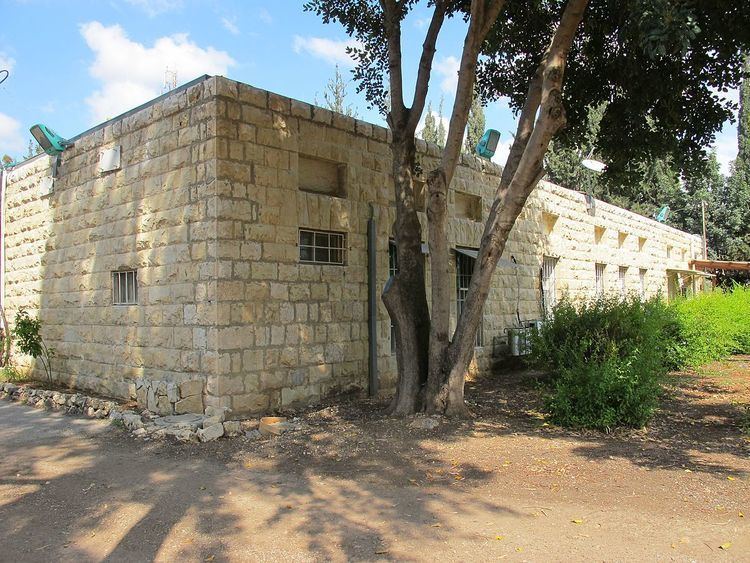Arabic بيت نبالا Subdistrict Ramle Date of depopulation 13 May 1948 | Name meaning "The house of archery" Palestine grid 146/154 Local time Tuesday 11:08 PM | |
 | ||
Also spelled Bayt Nabala, Beit-Nabbala Weather 21°C, Wind N at 13 km/h, 34% Humidity | ||
Tracing all that remains of bayt nabala
Bayt Nabala or Beit Nabala was a Palestinian Arab village in the Ramle Subdistrict in Palestine that was destroyed during the 1948 Arab–Israeli War. The village was in the territory allotted to the Arab state under the 1947 UN Partition Plan. Its population in 1945, before the war, was 2,310.
Contents
- Tracing all that remains of bayt nabala
- History
- British Mandate era
- 1948 war and aftermath
- Culture
- References
It was occupied by Israeli forces on May 13, 1948 and was completely destroyed by them on September 13, 1948. Village refugees were scattered around Deir 'Ammar, Ramallah city, Bayt Tillow, Rantis, and Jalazone refugee camps north of Ramallah. Some of the clans that lived in Bayt Nabala include the Nakhleh, Safi, AL-Sharaqa, al-Khateeb, Saleh and Zaid families. Today the area is part of the Israeli town of Beit Nehemia.
History
In 1596, Bayt Nabala was part of the Ottoman Empire, nahiya (subdistrict) of Ramla under the Liwa of Gaza, with a population of 297. It paid taxes on a number of crops, including wheat, barley, olives, fruit, as well as on goats, beehives and a press that was used for processing either olives or grapes. It had 54 Muslim families.
In 1870 Victor Guérin visited and found the village to have about 900 inhabitants, while an Ottoman village list from about the same year found 108 houses and a population of 427, though that population count included men only.
In 1882, the Palestine Exploration Fund's Survey of Western Palestine described Bayt Nabala as being of moderate size, situated at the edge of a plain.
British Mandate era
The school was founded in 1921 and had about 230 students in 1946-47.
In a census conducted in 1922 by the British Mandate authorities, Bait Nabala had a population of 1,324 inhabitants; 1,321 Muslims and 3 Christians, increasing in the 1931 census to 1758, all Muslims, in a total of 471 houses.
In 1944/45, the village had a population of 2,310 Muslims, while the total land area was 15,051 dunams, according to an official land and population survey. A total of 226 dunums of village land was used for citrus and bananas, 10,197 dunums were used for cereals, 1,733 dunums were irrigated or used for orchards, while 123 dunams were classified as built-up public areas.
1948 war and aftermath
On December 14, 1947 a convoy of 7 vehicles from Petah Tikva sought to relieve the Jewish settlement of Ben Shemen, which had come under siege. The convoy carried 26 soldiers from Tel Aviv, 13 auxiliary police, two residents of Ben Shemen and 7 drivers. On the way they came under fire and several men were wounded. A passing British military vehicle picked up the injured men and all 8 vehicles continued. Near Beit Nabala, they came close to an Arab Legion camp and a firefight ensued. According to Jewish sources, the Legion fired first; according to British sources, it was the Jews. The British vehicle and a police vehicle became stuck and received heavy fire. All of the wounded and most of the police were killed. In total, 13 men died. This was one of the first confirmed involvements of the Arab Legion in the fighting in Palestine. Some sources put the death toll at 14.
Benny Morris writes that the village residents abandoned it on Arab orders on 13 May 1948. However, according to Walid Khalidi, this cannot be confirmed.
The Palestinian historian Walid Khalidi described the village site in 1992: "The site is overgrown with grass, thorny bushes, and cypress and fig trees. It lies on the east side of the settlement of Beyt Nechemya, due east of the road from the Lod (Lydda) airport. On its fringes are the remains of quarries and crumbled houses. Sections of walls from the houses still stand. The surrounding land is cultivated by the Israeli settlements."
Culture
According to the Palestinian Heritage Foundation, Beit Nabala dresses (together with those of the village of Dayr Tarif), "were usually done on cotton, velvet or kermezot silk fabric. Taffeta inserts embroidered in Bethlehem style couching-stitch in gold and silk cord were attached to the yoke, chest panel, sleeves and skirt. In the 1930s black velvet material became popular, and dresses were embroidered in couching straight on the fabric with brown or orange couching embroidery which later became famous for this area."
